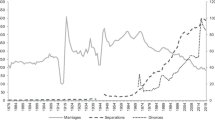Abstract
Augmented female marital status life tables are prepared and examined for the United States over the 2005–10 and 2015–20 intervals. The life tables span the ages of 15 to 50. No mortality is assumed over those ages, hence the tables only recognize the marital statuses of Never Married (S), Married (M), and Divorced (V). Fertility is added by recognizing parity states 0 through 5 in each marital state, yielding a model with 18 marital-parity states.
Summary measures derived from those life tables show a clear continuation of the retreat from marriage. Between 2005–10 and 2015–20, the probability of marrying by age 50 fell from 80% to 70%, the average age at first marriage increased by 1.1 years, and the Total Fertility Rate dropped from 1.96 to 1.71. Divorce rates fell, but the age 15–50 ratio of divorces to marriages dropped by only 9%.
The 2015–2020 rates indicate that nearly 20% of American women remain childless at age 50. Parity one was the modal parity, and a 0–2 child range appears to have replaced the 2–4 child range. Over the decade considered, the nonmarital proportion of all births increased to 41%. More than a fifth of all women had at least one child but never married by age 50.
Despite those broad trends, the continuing retreat of marriage was not a rout. Some 70% of women do marry by age 50, and the strengths of a stable partnership remain strong. The future course of American fertility is unclear, but marriage may well strengthen as better ways are found to reconcile gender equality with the demands of childrearing.
Access this chapter
Tax calculation will be finalised at checkout
Purchases are for personal use only
Similar content being viewed by others
References
Andersson, G., Thomson, E., & Duntava, A. (2017). Life table representations of family dynamics in the 21st century. Demographic Research, 37, 1081–1230.
Brown, S. L., & Lin, I.-F. (2022). The graying of divorce: A half century of change. Paper presented at the April Meeting of the Population Association of America in Atlanta.
CDC/NCHS National Vital Statistics System. (2022). Downloaded 6/19/2022 from cdc.gov/nchs/data/dvs/national-marriage-divorce-rates-00-20.pdf
Curtin, S. C., & Sutton, P. D. (2020). Marriage rates in the United States, 1900–2018. NCHS Health E-Stat.
Kennedy, S., & Ruggles, S. (2014). Breaking up is hard to count: The rise in divorce in the United States, 1980–2010. Demography, 51, 587–598.
Lesthaeghe, R. (2010). The unfolding story of the second demographic transition. Population and Development Review, 36, 211–251.
Manning, W. D., Brown, S. L., & Stykes, J. B. (2014). Family complexity among children in the United States. The Annals of the American Academy of Political and Social Science, 654(1), 48–65.
Osterman, M. J. K., Hamilton, B. E., Martin, J. A., Driscoll, A. K., & Valenzuela, C. P. (2022). Births: Final data for 2020. National Vital Statistics Reports (Vol. 70, no 17). National Center for Health Statistics.
Preston, S. H. (1976). Family sizes of children and family sizes of women. Demography, 13, 105–114.
Schoen, R. (2006). Dynamic population models. Springer.
Schoen, R. (2016). The continuing retreat of marriage: Figures from marital status life tables for United States females, 2000–2005 and 2005–2010. In R. Schoen (Ed.), Dynamic demographic analysis (pp. 203–215). Springer.
Schoen, R. (2019). On the implications of age-specific fertility for sibships and birth spacing. In R. Schoen (Ed.), Analytical family demography (pp. 201–214). Springer.
Schoen, R., & Baj, J. (1984). Twentieth century cohort marriage and divorce in England and Wales. Population Studies, 38, 439–449.
Schoen, R., & Nelson, V. E. (1974). Marriage, divorce and mortality: A life table analysis. Demography, 11, 267–290.
Schoen, R., & Standish, N. (2001). The retrenchment of marriage: Results from marital status life tables for the United States, 1995. Population and Development Review, 27, 555–563.
Schoen, R., & Weinick, R. M. (1993). The slowing metabolism of marriage: Figures from 1988 U.S. marital status life tables. Demography, 30, 737–746.
Schoen, R., Urton, W., Woodrow, K., & Baj, J. (1985). Marriage and divorce in twentieth century American cohorts. Demography, 22, 101–114.
United States Census Bureau. (2010). Table 57. Marital status of the population by sex and age: 2010. Downloaded 6/10/2022 from www.census.gov/population/www/socdemo/hh-fam/cps2010.html
United States Census Bureau. (2018). Table 2. Marital status of the population 15 years and over by sex and age: 2016. Current Population Survey, Annual Social and Economic Supplement, 2016. Released August 2018.
United States Census Bureau. (2021) Table A1. Marital status of people 15 years and over, by age, sex, and personal earnings: 2021. Downloaded 7/3/2022 from www.census.gov/data/tables/2021/demo/families/cps-2021.html
Westrick-Payne, K. (2022). A profile of national and state-level marriage rates in the U.S., 1880–2018: A research note. Paper presented at the April Meeting of the Population Association of America in Atlanta.
Acknowledgements
Helpful comments from Lowell Hargens are gratefully acknowledged.
Author information
Authors and Affiliations
Editor information
Editors and Affiliations
Appendix
Appendix
Rights and permissions
Copyright information
© 2023 The Author(s), under exclusive license to Springer Nature Switzerland AG
About this chapter
Cite this chapter
Schoen, R. (2023). A Multistate Analysis of United States Marriage, Divorce, and Fertility, 2005–10 and 2015–20: The Retreat from Marriage Continues. In: Schoen, R. (eds) The Demography of Transforming Families. The Springer Series on Demographic Methods and Population Analysis, vol 56. Springer, Cham. https://doi.org/10.1007/978-3-031-29666-6_7
Download citation
DOI: https://doi.org/10.1007/978-3-031-29666-6_7
Published:
Publisher Name: Springer, Cham
Print ISBN: 978-3-031-29665-9
Online ISBN: 978-3-031-29666-6
eBook Packages: Social SciencesSocial Sciences (R0)




